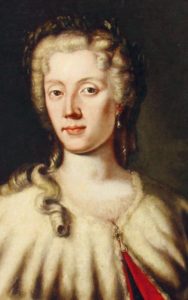 Her father was there to listen to her, sitting in the front row of the Anatomy Theatre of the Archiginnasio in Bologna.
Her father was there to listen to her, sitting in the front row of the Anatomy Theatre of the Archiginnasio in Bologna.
The occasion was solemn, for never before had a woman lectured at the oldest university in the western world.
And so, on the morning of 17 December 1732, the monumental hall was packed, if only with men, all gathered to pay homage to her, “professora” Laura Bassi, to whom the Bologna Academic Senate had just conferred the honorary chair of “Filosofia Universa”, as experimental physics was then known.
Born in Bologna on 29 October 1711, Laura, barely 20 years old, was not intimidated by the audience, which consisted mainly of doctors and members of the local aristocracy, and astonished everyone with her eloquence and perfect knowledge of the subject.
Even as a child she had shown a lively intelligence, with a particular inclination to study philosophy, physics and mathematics, subjects that went hand in hand in those days.
Never hindered, but on the contrary encouraged by a decidedly avant-garde family and social environment, which already breathed the healthy breeze of the “Enlightenment”, under the guidance in particular of the family doctor Gaetano Tacconi, Laura had committed herself to studying hard, So much so that in April of the same year, in the Palazzo Pubblico in Bologna, she had brilliantly argued ‘De universa re philosophica’ in front of five scholars who pestered her with their questions, obtaining a degree in philosophy ‘magna cum laude’, again the first woman ever to achieve this goal.
She was so well known and loved in the city that the Archbishop of Bologna, Prospero Lambertini, a man of rare intelligence and wit, took her under his wing, paving the way and allowing her to freely consult the ‘forbidden books’, as the texts of Galileo, Kepler and Copernicus were then classified, when she reached the age of majority, which was 24.
Lambertini did not forget her after his election as Pope Benedict XIV. In 1745, despite the opposition and envy of her male colleagues, he appointed her a member of the ‘Accademia Benedettina’ and granted her an annual pension of 100 lire.
In the meantime, Laura was able to perfect her studies in physics, following the footsteps of Newton’s theories, which she was to play a decisive role in spreading in Italy, not least because in 1738 she married the doctor Giuseppe Verratti, beginning a married life of love and mutual respect that, in addition to the birth of a brood of eight children, would anticipate by about 150 years the intense human and professional history of the Curie couple in Emilia.
When she died on 20 February 1778, she was buried in the church of Corpus Domini.
In 1891, the Scuola Normale Superiore Femminile in Bologna was named after her, as were a high school, a crater on the planet Venus, an asteroid discovered in 1991 and, most recently, a research vessel. (Text by Anselmo Pagani)
Émilie du Châtelet, admitted to the Academy of Sciences of the Bologna Institute in April 1746, was one of his admirers.
You cannot copy content of this page








